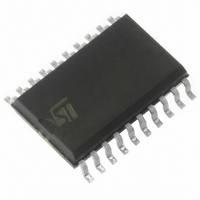ST7FDALIF2M6TR STMicroelectronics, ST7FDALIF2M6TR Datasheet - Page 103

ST7FDALIF2M6TR
Manufacturer Part Number
ST7FDALIF2M6TR
Description
IC MCU 8BIT 8K FLASH 20-SOIC
Manufacturer
STMicroelectronics
Series
ST7r
Datasheet
1.ST7DALI-EVAL.pdf
(171 pages)
Specifications of ST7FDALIF2M6TR
Core Processor
ST7
Core Size
8-Bit
Speed
8MHz
Connectivity
DALI, SPI
Peripherals
LVD, POR, PWM, WDT
Number Of I /o
15
Program Memory Size
8KB (8K x 8)
Program Memory Type
FLASH
Eeprom Size
256 x 8
Ram Size
384 x 8
Voltage - Supply (vcc/vdd)
2.4 V ~ 5.5 V
Data Converters
A/D 7x10b
Oscillator Type
Internal
Operating Temperature
-40°C ~ 85°C
Package / Case
20-SOIC (7.5mm Width)
Processor Series
ST7DALI
Core
ST7
Data Bus Width
8 bit
Data Ram Size
384 B
Interface Type
DALI, SPI
Maximum Clock Frequency
8 MHz
Number Of Programmable I/os
15
Number Of Timers
3
Maximum Operating Temperature
+ 85 C
Mounting Style
SMD/SMT
Development Tools By Supplier
ST7FLITE-SK/RAIS, ST7DALI-EVAL, ST7MDT10-DVP3, ST7MDT10-EMU3, STX-RLINK
Minimum Operating Temperature
- 40 C
On-chip Adc
10 bit, 7 Channel / 13 bit, 7 Channel
Lead Free Status / RoHS Status
Lead free / RoHS Compliant
Available stocks
Company
Part Number
Manufacturer
Quantity
Price
Company:
Part Number:
ST7FDALIF2M6TR
Manufacturer:
NEC
Quantity:
670
ST7DALIF2
17.4.2
Note:
Note:
Note:
Note:
Figure 48. Hardware/software slave select management
Master mode operation
In master mode, the serial clock is output on the SCK pin. The clock frequency, polarity and
phase are configured by software (refer to the description of the SPICSR register).
The idle state of SCK must correspond to the polarity selected in the SPICSR register (by
pulling up SCK if CPOL=1 or pulling down SCK if CPOL=0).
How to operate the SPI in master mode
To operate the SPI in master mode, perform the following steps in order (if the SPICSR
register is not written first, the SPICR register setting (MSTR bit) may be not taken into
account):
1.
The slave must have the same CPOL and CPHA settings as the master.
2.
3.
MSTR and SPE bits remain set only if SS is high.
Important: if the SPICSR register is not written first, the SPICR register setting (MSTR bit)
may be not taken into account.
The transmit sequence begins when software writes a byte in the SPIDR register.
Master mode transmit sequence
When software writes to the SPIDR register, the data byte is loaded into the 8-bit shift
register and then shifted out serially to the MOSI pin most significant bit first.
When data transfer is complete:
Clearing the SPIF bit is performed by the following software sequence:
1.
2.
– Select the clock frequency by configuring the SPR[2:0] bits.
– Select the clock polarity and clock phase by configuring the CPOL and CPHA bits.
– Either set the SSM bit and set the SSI bit or clear the SSM bit and tie the SS pin high
– Set the MSTR and SPE bits
– The SPIF bit is set by hardware
– An interrupt request is generated if the SPIE bit is set and the interrupt mask in the
Write to the SPICR register:
Write to the SPICSR register:
Write to the SPICR register:
An access to the SPICSR register while the SPIF bit is set
A read to the SPIDR register.
Figure 49
for the complete byte transmit sequence.
CCR register is cleared.
shows the four possible configurations.
SS external pin
SSI bit
SSM bit
1
0
SS internal
Serial peripheral interface (SPI)
103/171













